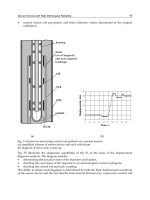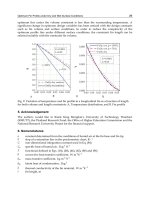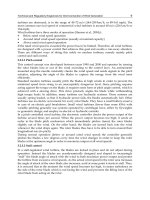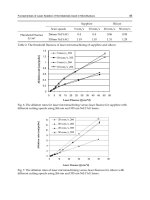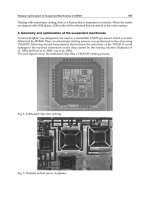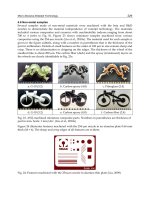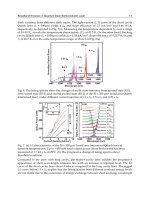Cultivation of soya and other legumes - Part 2 pot
Bạn đang xem bản rút gọn của tài liệu. Xem và tải ngay bản đầy đủ của tài liệu tại đây (399 KB, 17 trang )
Cultivation of soya and other legumes 10
3 Cultivation requirements for
legumes
This chapter is about how to grow soya and other legume crops. To
grow legumes successfully farmers need to know about the following:
? climate requirements
? soil type and soil fertility requirements
? when to sow
? suitable varieties
? how to combine legume crops with other activities on the farm
Practical examples show how legumes can be integrated into local
farming systems and under which conditions legumes grow well in
different areas of the world.
3.1 Suitable areas
Legumes and soya can be grown under a wide range of agroclimatic
conditions. We list the main ones here to give the reader an idea of the
variety of conditions under which legumes do well.
Upland river terraces and hills where shifting cultivation takes
place
Shifting cultivation is a system in which farmers cut down an area of
trees, burn the remaining vegetation and use the land they have
cleared for agriculture. The ash from the burned material contains a lot
of nutrients, so the soil is fertile and in the first season crops with high
nutrient requirements can be grown. In the following seasons other
crops are grown.
In traditional shifting cultivation systems a piece of land was usually
used for three or four years, after which the soil was exhausted and
weeds would start to take over. The land would then be left fallow for
a period of 10 to 15 years, giving the soil time to recover after which
the cycle would start again. This system is now under pressure how-
Cultivation requirements for legumes 11
ever as the fallow period becomes shorter, and the soil and vegetation
have less and less time to regain fertility. In many places land is culti-
vated after each rainy season; weeds become more and more difficult
to control and soil fertility is decreasing. The lack of nitrogen in the
soil is a big problem. Legumes can help to restore nitrogen deficien-
cies and stop weeds taking over. For example, Mucuna utilis can help
to suppress Imperata, a stubborn grassy weed which prevents farmers
from cultivating land.
Figure 1: Example of shifting cultivation where not all trees have
been felled.
Lowland along rivers and coastal areas where rice is often grown
The soils in these areas are surrounded by rivers. Coastal areas where
mangroves used to grow are often not suitable for legumes as they are
too acid once they have dried out after the rice harvest. Other soils in
these areas that are not subjected to salt water are less acid and more
Cultivation of soya and other legumes 12
suitable for agriculture. If these areas are submerged under water dur-
ing the rainy season, rice is the only crop that can be grown. If the wa-
ter recedes after the rice harvest, legumes can be grown as a second
crop, making use of the moisture that remains in the soil. If it is possi-
ble to irrigate, the land can also be used in the dry season.
Highland areas
Many legume food crops are grown at altitudes above 1000 metres.
Highland areas are characterized by low temperatures, dryness and a
relatively short growing season. The fields are often small, which
makes it difficult to use machines. Farmers work the land by hand or
using animal traction. Legumes are grown on their own or in combina-
tion with other crops such as maize. The yields are often low, but the
beans are an important source of protein for many families. Legumes
such as chickpeas, peas, broad beans and lentils are grown in areas
where the soils are poor because they are resistant to drought, and the
crop remains can be used as animal feed.
Erosion is a common problem in these marginal areas. In some areas
farmers work the land in such a way as to ensure that the ridges run
horizontally as far as possible, following the contour lines. Rainwater
is caught by the ridges and so seeps down slowly into the soil. If the
ridges are made that follow the slope, rainwater runs off quickly, tak-
ing soil with it and causing erosion. If the rainfall is very heavy the
soil cannot always absorb the water quickly enough. The water will
then flow over the ridges, breaking them and causing serious erosion.
In areas where this is a problem it is better to build the ridges diago-
nally over the slopes, so that some of the water is caught and can seep
into the soil, and the rest can run off.
In the Bolivian highlands, where the amount of rainfall varies a lot,
traditional methods are used to try and predict how much rain is likely
to fall. If a lot of rain is expected the ridges are dug so that they run
more in the direction of the slope; if less rain is expected the ridges are
made so that they run more or less parallel with the contour lines.
Cultivation requirements for legumes 13
3.2 Climate
Using local climate data and the data in Appendix 1 you can start to
decide which legumes may be suitable to grow in your area. Some
legumes grow better in cooler climates, where there are cold periods,
others do better in a humid and warm climate, such as lowland areas
in the tropics. Others are adapted to extremely arid and hot conditions.
Legumes for different climates
Food legumes as a group have a very wide range of adaptability with
respect to latitude, temperature, day length and humidity. While some
of them grow optimally at relatively low temperatures in long days,
others flourish at high temperatures associated with a day length of 12
hours or more. This is perhaps one of the reasons that in almost every
conceivable climate one food legume or other exists. Nevertheless, the
fact remains that the adaptability of each species or cultivar individu-
ally is rather restricted (Sinha, 1977).
Cool climates with cold periods at high latitudes or in higher areas
of the tropics
Beans grown in moderate climates come from western Asia and the
Mediterranean, where they have been grown for thousands of years.
These include lentils (Lens culinaris), peas (Pisum sativa), kidney
beans (Phaseolus sp.) and chickpeas (Cicer arietinum). The cultiva-
tion of these crops spread over time to the Indian subcontinent and
China. Peas and broad beans (Vicia faba) also spread northwards to
the cooler areas of northern Europe, and later were also taken to North
and South America, Australia and South Africa. They are also found in
highland areas of African countries such as Ethiopia and Kenya.
Humid tropical climates
Soya (Glycine max) and pigeon peas (Cajanus cajan) are suitable for
warm, humid climates.
Hot arid climates
Cowpea (Vigna inguiculata), green gram (Vigna aureus), black gram
(Vigna mungo) and groundnut (Arachis hypogaea) can tolerate ex-
Cultivation of soya and other legumes 14
treme dryness and high temperatures. Groundnuts, for example, are
grown in semi-arid and low-humid tropical areas of Africa, Southeast
Asia and Central America between 30° North and 30° South.
Climate requirements for soya
In Bolivia soya is grown in the subtropical areas between 15° and 20°
South, at low altitudes (< 700 metres above sea level) where tempera-
tures are quite high (22 – 32°C), relative humidity is high (> 65%),
day length is short (12 – 13 hours) and annual rainfall is between 800
and 1300mm.
Figure 2: Soya needs the correct temperature, day length and
amount of water to grow well.
The minimum temperature at which soya develops is 10°C, the opti-
mal temperature is 22°C and the maximum is about 40°C. The seeds
germinate well at temperatures between 15°C and 40°C, the optimal
temperature being about 30°C.
Cultivation requirements for legumes 15
Adaptation to cold
Much soya is grown in areas with temperatures around 25°C – 30°C.
It seems that nighttime temperature has a greater influence on the crop
than daytime temperature. If the night-time temperature falls below
the critical level of 10°C the crop will undergo more damage than if
the night-time temperature stays above 10°C, regardless of the optimal
daytime temperature range of 25°C – 30°C.
In Tokachi (Japan, between 42°20' and 43°30' N) soya yields per hec-
tare are considerably lower in years when the temperature is cooler
than average. When temperatures are lower the soya flowers later, rip-
ens later, develops fewer pods and produces a lower weight of beans.
Generally speaking, cultivars with big seeds, pubescent (hairy), wide
leaves and vigorous early-stage growth have relatively good yields in
cool years. Glabrous (smooth-leaved), less robust cultivars form fewer
beans and have lower yields. There is a clear connection between
early-stage growth vigour and yield. The better the plant develops in
the early stages of growth the higher the bean yield will be, especially
under cool temperatures. Cultivars with small seeds germinate
quickly, but are not resistant to cold temperatures.
Water requirements
Soya has two critical periods concerning water requirements: from
sowing to germination, and the period during which the beans grow in
the pods. Before a seed can germinate it needs to absorb 50% of its
weight in water. Nevertheless during the germination phase too much
water causes more damage than too little water. The soil needs to be
between 50% and 85% saturated with water. The amount of water
needed increases as the crop grows, reaching its maximum as the
beans develop in the pods (7 – 8 mm per day), and then decreases
again. To be sure of a good yield, soya needs between 450 and 800
mm water each day during its whole growth cycle, depending on the
climate. In high temperatures more water evaporates, so more rainfall
is needed to provide the crop with enough water.
Cultivation of soya and other legumes 16
3.3 Varieties and cultivars
Legumes
Figure 3: Seeds of different types of legumes. Note the differences
in shape and size!
Local varieties of most sorts of legumes have developed and many
agricultural institutes all over the world have bred cultivars with desir-
able characteristics such as resistance to disease and pests, higher
yields and shorter ripening time. Farmers often know a lot about local
varieties and the conditions under which they grow well. They often
grow different varieties of the same crop in order to spread their risks.
If a field sown with one variety suffers damage in the form of disease,
pests or bad weather, it is still possible that a field with a different va-
riety will suffer less from the problems. The cultivars developed by
agricultural test stations can often be a good addition. In cases where a
new type of legume is introduced, farmers often have no choice but to
use the cultivars offered by the local agricultural institute. The choice
is usually too limited to be able to spread risks. The introduction of a
single cultivar or variety carries high risks for farmers. If a new leg-
ume crop is to be introduced into a certain area it is important to en-
sure that farmers can choose between a number of cultivars and/or
varieties. If this is not possible it is recommended that different types
of legume crops are introduced (Appendix 1).
Cultivation requirements for legumes 17
Different varieties of a crop have different genetic characteristics. The differ-
ences have arisen as a result of the crop being cultivated under different con-
ditions to which it has adapted.
Cultivars also have different genetic characteristics, but these have arisen
through cross breeding or genetic manipulation under controlled conditions,
for example in an agricultural institute.
Day-length sensitivity will determine the choice of legume made, not
only the type but also the variety. (Labour requirements are also im-
portant when choosing a variety. See paragraph 4.4.)
Soya
Soya is a short-day plant, and is sensitive to day length. It flowers
when the day length is shorter than 16 hours. Short-cycle varieties
flower 30 – 35 days after sowing and ripen within 75 – 105 days.
These varieties have low yields. The middle-length varieties also
flower 30 – 35 days after sowing and mature within 110 – 140 days.
These have good yields. The long-cycle varieties produce a large
amount of leaf material.
Figure 4: Day length: soya flowers when the day length is shorter
then 12 – 14 hours.
In integrated farming systems where livestock are raised this soya leaf
material is an attractive form of animal feed; it is easily digestible and
contains a lot of protein. In Ivory Coast (West Africa) short-cycle va-
rieties do better because the rainy season is short.
Cultivation of soya and other legumes 18
3.4 Soil
If legumes are to grow well, the soil must fulfil certain requirements.
You can find more information on these in the tables in Appendix 1.
However, it is not a one-sided relationship. Legumes also contribute to
soil fertility, which is good for the crops grown after the legume crop.
Soil conditions
Legumes grow in different soils, even very acid soils (up to pH 3.8).
Groundnuts and Bambara groundnuts (Vigna subterranea) grow in
poor sandy soils and loamy soils, but also in clay soils such as verti-
sols, although harvesting the pods from under the ground is difficult.
While groundnuts grow well in chalky soils, Bambara groundnuts do
not. Good drainage is important, especially for Vigna and Phaseolus
types.
The butterbean (Lablab purpureus) has deep roots, which enable it to
grow better on badly draining soils than most legumes. The butterbean
however does not do well in saline (salty) soils. Generally speaking,
legumes do not do well on salty soils, although there are a few excep-
tions: pigeon pea (Cajanus cajan) and pea.
Soya grows best in soils that are not too light and not too heavy in tex-
ture. Soya does not germinate easily in heavy clay soils, although it
does grow well in them after germination. If a heavy soil has been
well prepared it is preferable to a light sandy soil, as the yields are
likely to be more certain. Soya grows well in soils with high organic-
material content. Soya prefers a pH of between 5.8 and 7.8, and does
not like alkaline or acid extremes. Soya will not tolerate saline soils.
Improving soil fertility
It appears that high-yielding strains do not contribute much nitrogen to
the soil. The most important role of legumes in a farming system is
their bean production. During the growth cycle the transfer of nitrogen
to other crops is small. It is only when the crop remains have been dug
Cultivation requirements for legumes 19
Figure 5: Soils and growth of legumes
Cultivation of soya and other legumes 20
into the soil and have decomposed that they start to release their nitro-
gen into the soil, making it available to the next crop. Figures from
Bolivia show that maize and wheat grown after soya can have an in-
crease in yield of up to 22%. Where legumes are used as green ma-
nure, maize yields are clearly higher than maize grown after a short
fallow period where nothing is grown. If soya is grown for use as
green manure, where the whole crop is dug under, it can increase soil
fertility by up to 200 kg nitrogen per hectare. Soya dug in in this way
also improves the texture of the soil because the crop residue contrib-
utes organic material.
If soya is grown as part of a mixed cropping system it is important to
ensure that nitrogen given to the other crop in the form of artificial
fertilizer does not come into contact with the roots of the soya. Soya
will not fix nitrogen (or only very little) if there is nitrogen present in
the soil (in this case from the artificial fertilizer).
When the remains of the soya and other crops are dug into the soil
together, the nitrogen-rich soya remains will ensure that the organic
material in the soil is broken down quickly. This will increase the
amount of nutrients in the soil by more than if the remains are dug in
separately.
Integrating legumes into existing farming systems 21
4 Integrating legumes into existing
farming systems
Farmers and extension workers who have no experience of legumes
need to find the answers to a number of questions:
? What is the best season for growing legumes?
? What crops grow best before or after the legumes?
? Or is it better to grow them at the same time?
The existing farming system must be taken into account if you are to
understand how you can integrate leguminous crops.
Farming and crop systems
A farming system consists of all the farming activities that take place on a
farm. These may include crop cultivation, raising livestock or planting trees.
A crop system consists of all the crops that are grown. Sometimes this is one
crop on a field (monocropping), sometimes several crops. If several crops are
grown together on one field, they can be mixed up together (mixed cropping)
or planted in alternating rows (intercropping). It is also possible to sow one
crop later than the other one in the field (relay cropping).
Appendix 1 is a list of leguminous crops and their climate, water, tem-
perature and soil requirements. The table can be used to make a pre-
liminary selection from the many legumes available.
This chapter is mainly devoted to soya. However many of the charac-
teristics of most other leguminous crops are similar. With a few excep-
tions, most leguminous crops are sensitive to day length: they are ei-
ther short-day or long-day plants. Soya is a short-day plant: it starts to
flower when the number of hours of sunshine in a day decreases. The
exact amount varies between 12 and 14 hours, depending on the vari-
ety of soya. For this reason the latitude where particular varieties can
be grown is always included in the examples given in this Agrodok
(paragraph 3.3: Varieties). The nearer the equator (lower latitudes) the
more constant the day length is and the warmer the nights are
throughout the year. Further away from the equator (higher latitudes)
Cultivation of soya and other legumes 22
the days are shorter and colder during the winter. During the summer
the days are longer and temperatures are higher both during the day
and at night.
Figure 6: Intercropping and mixed cropping
Integrating legumes into existing farming systems 23
In Africa, Asia and to a lesser extent Latin America, most crops are
cultivated manually. This makes it easier to integrate legumes into the
farming system. They can be grown as a monocrop (crop grown on its
own), as an intercrop with dry rice or maize, or as a relay crop just
before or after the main crop that requires the rain. All these crop sys-
tems are used successfully in Taiwan. The introduction of groundnuts,
soya and mung beans in rain-dependent farming systems in northern
Thailand has also had good results.
4.1 Livestock keeping
We describe two ways of integrating legumes with livestock keeping.
1 When the beans have been harvested the crop residue is used as
animal feed for the livestock kept in the village, e.g. cattle or buf-
falo. The dung from the animals is used to fertilize the land together
with the crop remains left in the soil, which increases the nitrogen
content of the soil.
2 You can also let livestock graze in a mixed crop of a legume and
grain. For example, you let the animals eat half of the legume crop.
Animals will first eat legumes because they contain a lot of protein,
which means they will leave the grain crop undisturbed. As they eat
the legumes, nitrogen will be released which is good for the grain
crop, such as maize. The animals convert the nitrogen in the soya
into urine and dung. The nitrogen in the urine is immediately taken
up by the grain crop.
The second method appears to provide more nitrogen, but farmers are
unlikely to let their animals eat much of the legumes that are meant for
human consumption. It is difficult to calculate exactly how much this
method improves soil fertility. If a farmer is accustomed to using arti-
ficial fertilizer it would be possible to carry out a cost-benefit analysis
to determine which form of fertilizing is cheaper.
Cultivation of soya and other legumes 24
4.2 Mixed/rotational cropping systems in Asia
Figure 7: Example of rotational cropping: in the first year fields 1
and 2 are cultivated (A). In the following year all crops move round
one field, so fields 2 and 3 are cultivated (B).
The main leguminous crop in Asia is soya, so the examples below all
refer to this crop. Soya is usually sown in the dry season, after rice,
wheat or maize while the soil still contains sufficient moisture, or
where irrigation is possible. Soya is also often intercropped with
maize or sorghum.
In Indonesia a similar system at 6°N yields 700 kg soya per hectare.
The soya is sown at the end of the rains in February or March, or just
after the rains have stopped in April. If the rains are to be used for the
legume crop, then sowing is done in July/August just before the first
rains start, so that the seed is ready to benefit from the rains that start
in September. The harvest takes place at the end of the rainy season,
between December and April or in the dry season at the end of June,
depending on when the soya was sown. If the seed is sown in the dry
season, the crop starts to grow during the rains and it takes one or two
months longer before it can be harvested.
In Thailand yields up to 1200 kg/ha are harvested at a latitude of
15°N. In this area most soya is sown during the rains between April
and July. Where there is irrigation, soya is sown at the beginning of
the dry season in December. In Taiwan a similar system of cultivation
Integrating legumes into existing farming systems 25
is used at 23°N and yields of 1500 kg/ha are achieved. Here the dry
season is from November to May and the rains fall between May and
October.
4.3 Mixed/rotational cropping systems in africa
In Uganda legumes are grown in various shifting cultivation systems.
A number of crop systems in which different legumes are grown are
listed in table 3.
Table 3: Crop systems used in Uganda (Source: Stanton 1966: 61)
Sole crop or
intercrop
Intercropped
with
Position in
rotation
Sole crop
recommended
spacing (cm)
groundnuts both maize/cotton 1
st
or 2
nd
year of
cultivation
60-40 x 15 with
animal traction
or 30 x 30 hand
cultivated
kidney bean usually inter-
cropped
maize/cotton/sor
ghum/ young
coffee, bananas
and cassava
1
st
, 2
nd
or 3
rd
year
60 x 15 (in dou-
ble rows)
cowpea usually sole
crop
2
nd
or 3
rd
year 50 x 40
pigeon pea intercrop finger millet
(Eleusine cora-
cana)
2
nd
year of
garden pea both kidney
beans/maize
1
st
or 2
nd
year
The legumes in this example are not cultivated on ridges, and they are
not irrigated. Reading the table it can be seen that groundnuts are
grown as sole crop, but are also grown between other crops (inter-
cropping), usually maize or cotton. Groundnuts are the first or second
crop grown after a fallow period. Optimal spacing has also been calcu-
lated: if the groundnuts are the sole crop and the soil is worked using
animal traction it is best to allow 40 to 60 cm between the rows and 15
cm between plants within the rows. If the work is done by hand it is
better to have crop spacing of 30 x 30 cm.
Cultivation of soya and other legumes 26
4.4 Labour requirements
Table 4 below gives an indication of the amount of time in hours
needed to cultivate one hectare of soya (monoculture).
Table 4: Labour required (in hours) to cultivate one hectare of
soya.
Soil preparation mechanized 84
Sowing manual 100
mechanized 8
First weeding manual 100
mechanized 8
Second weeding manual 80
mechanized 8
Harvesting manual 90
Transport to storage place 40
Threshing 150
Winnowing 69
Total manual (soil preparation mechanized) 724
Total weeding also mechanized 364
Sowing soya by hand is very labour intensive. The sowing density
must be very high to ensure a good yield. The only way to keep weeds
down is by letting the soya plants cover the whole of the ground. Most
other leguminous crops have a wider branching pattern, which means
that the sowing density is lower. Other legumes therefore take less
time to sow.
The other figures in table 4 give an indication of the amount of labour
needed for growing most legumes, not just soya. The amount of time
needed for harvesting however varies depending on the crop: how it
grows and the size of the pods. There are varieties of legumes that all
ripen at once, so that suddenly a large amount of labour is needed at
the same time if no beans are to be lost. Where cultivation is largely
mechanized, a crop that ripens all at the same time is preferred as this
is easy to do by machine. Where farming families harvest by hand it is
usually better if the work can be spread out over a longer period with a
variety that does not ripen all at once. It is important to be aware that
these characteristics vary in some legumes depending on the variety.

